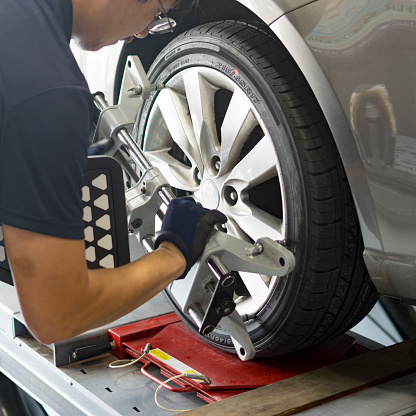December 21, 2024
Does Your Vehicle Need Wheel Alignment?
- Your vehicle pulls to one side while driving.
- Your steering wheel is off-center when you’re driving straight.
- Your tires are wearing unevenly.
- You’re experiencing vibration or shaking in the steering wheel.
If you’re experiencing any of these symptoms, it’s possible that your vehicle needs a wheel alignment. It’s important to have your vehicle inspected by a qualified mechanic to diagnose the problem accurately and determine if a wheel alignment is needed. Regular wheel alignments can help ensure that your vehicle drives smoothly, your tires wear evenly, and your steering system functions properly.
IS WHEEL ALIGNMENT REALLY NECESSARY?
- Safety: A vehicle with misaligned wheels can be unsafe to drive because it can pull to one side, making it difficult to control. This can be especially dangerous when driving at higher speeds or in hazardous road conditions.
- Tire Wear: Misaligned wheels can cause uneven tire wear, which can reduce the lifespan of your tires and cost you more money in the long run.
- Fuel Efficiency: Misaligned wheels can also cause your vehicle to use more fuel than necessary because it creates extra resistance, making your engine work harder.
- Handling: When your wheels are properly aligned, your vehicle will handle better, making it easier to drive and giving you a more comfortable and enjoyable driving experience.
In summary, while it may be possible to drive with misaligned wheels, it’s not recommended because it can affect your safety, cost you more money in tire replacement and fuel expenses, and reduce your overall driving experience. Therefore, it’s important to have your wheels aligned regularly to ensure that your vehicle is operating at its best.
![]() HOW OFTEN SHOULD YOU GET A WHEEL ALIGNMENT?
HOW OFTEN SHOULD YOU GET A WHEEL ALIGNMENT?
Additionally, you should also have your wheels aligned if you notice any signs of misalignment, such as pulling to one side, uneven tire wear, or a crooked steering wheel. Also, it’s a good idea to have your wheels aligned after any major suspension or steering repairs, such as after replacing tie rods, ball joints, or shocks.
It’s important to note that regular maintenance of your tires and suspension system can help prolong the lifespan of your tires and prevent issues with wheel alignment. Therefore, you should have your tires rotated regularly, maintain proper tire pressure, and inspect your suspension system periodically. By doing so, you can help reduce the frequency of wheel alignments and ensure that your vehicle is operating at its best.
HOW DO YOU KNOW YOU NEED AN ALIGNMENT?
- Your vehicle pulls to one side: If you notice that your vehicle pulls to one side while driving, it may be an indication that your wheels are misaligned. This can be especially noticeable when driving on a straight road.
- Uneven tire wear: Check your tires for uneven wear patterns. If you see that one side of the tire is wearing more quickly than the other side or if the tire is worn on the inside or outside edge, it may be a sign of misaligned wheels.
- Crooked steering wheel: If your steering wheel is off-center while driving straight, it may be an indication that your wheels are misaligned.
- Vibration or shaking: If you feel a vibration or shaking in the steering wheel while driving, it could be due to misaligned wheels.
- Squealing tires: If your tires are squealing while turning, it may be an indication that your wheels are misaligned.
If you notice any of these signs, it’s recommended to have your vehicle inspected by a qualified mechanic to determine if a wheel alignment is necessary. Regular wheel alignments can help ensure that your vehicle drives smoothly, your tires wear evenly, and your steering system functions properly.
HOW LONG DOES AN ALIGNMENT TAKE?
A wheel alignment typically takes about 1 to 1.5 hours. The exact time can vary based on several factors:
- Type of Alignment:
- A two-wheel alignment (for front-wheel or rear-wheel drive vehicles) generally takes less time.
- A four-wheel alignment (for all-wheel drive or vehicles with independent suspension) may take slightly longer.
- Condition of the Vehicle:
- If components like suspension or steering parts are worn or damaged, repairs may extend the time.
- Complexity of the Vehicle:
- Performance or luxury vehicles with advanced suspension systems may require additional time.
- Shop Efficiency:
- The equipment and experience of the technicians can impact how quickly the alignment is completed.
If you’re scheduling an appointment, it’s a good idea to confirm with the shop how long they expect it to take.


